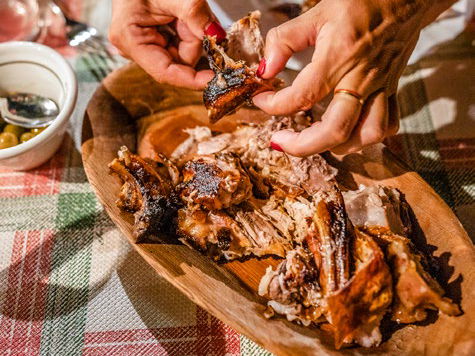Porceddu Sardu
Porceddu Sardu
Sardinian-Style Suckling Pig
This dish, more than any other in this book, elicits a visceral reaction. I get it. A baby pig carcass is, for lack of a better verb, impaled, then spit-roasted for hours at a distance from the flames that ensures slow, even cooking. Some Sardinian traditions call for a horizontal turning spit, while others lean the animal diagonally, turning it at regular intervals. Some butterfly the pig, others leave it whole. Given that you’re cooking the entire animal, head and all, over an open fire, there’s no way to ignore the fact that you are preparing a piglet. Sardinians are keenly aware of this, and are highly reverent of the butchered piglet, reserving its slaughter for special occasions and holidays, because it’s a big deal to eat an animal before it matures and becomes even more economically valuable. In Sardinia in particular, pigs provided families with food and income, so no part was ever wasted, not even the blood, which was used as a thickening agent for sweets, or the bristles, which were used for making brushes. Because the porceddu meat is so precious, the roasting process is entrusted to a pitmaster experienced in the art of roasting, who will ensure maximum flavor and tenderness. Cooking must happen slowly over indirect heat to properly break down the piglet’s abundant collagen while cooking the meat. The final product is tender and savory and loaded with flavor. Suckling pig is a luxury, both in Sardinia and in the US. A single maialino sardo weighs 12 to 15 pounds, while most American suckling pigs range from 15 to 50 pounds and could run you $200 or more. I’ve included a variation for roasting a quarter of a suckling pig in the oven, so it’s more approachable price- and portion-wise, but if you have the equipment and means to roast a whole piglet, go for it. Just know that the more you practice the better the results will be. Order it from a specialty butcher a week or more in advance.
In Sardinia, porceddu is sliced after resting, then served on a cork platter lined with myrtle branches. Improvise with whatever large platter and aromatic herbs you have in your garden. I like to serve it with a bright and acidic salad like Insalata Pantesca to cut through the fat.
Ingredients (2)
Ingredients (2)
Porceddu Sardu
Instructions
Place the suckling pig (15 lb) on an extra-large rimmed baking sheet. Massage the meat all over with the salt (¼ cup), inside and out.
Refrigerate, uncovered, for at least 6 hours or up to overnight to allow the skin to dry out.
Remove the pork from the refrigerator about 1.5 hours prior to cooking and set aside to bring the meat to room temperature.
Set up a rotisserie attachment for your grill and heat the grill to 350°F.
Drain off any liquid and pat dry. Pass the rotisserie spit through the mouth and body cavity of the pig, then between the legs.
Truss the legs and secure the pig to ensure it doesn’t move on the spit as it turns.
Place the spit on the rotisserie and cook until the meat’s internal temperature reaches 160°F, 2 to 3 hours.
Increase the grill temperature to 500°F and cook until the skin is crisp and blistered.
Set aside to cool for at least 30 minutes before slicing and serving.
Maialino al Forno (Oven-Roasted Suckling Pig)
Place 1/4 skin-on suckling pig (about 4 pounds) on a rimmed baking sheet. Rub on both sides with 2 tablespoons kosher salt. Follow the instructions on the right for resting in the refrigerator and bringing the meat to room temperature before cooking.
Preheat the oven to 275°F
Transfer the suckling pig to a roasting pan fitted with a wire rack and roast until the meat is fork-tender and the internal temperature reaches 160°F, 3 to 4 hours.
Increase the oven temperature to 500°F and roast until the skin is crisp and blistered, 15 to 20 minutes more.
Set aside to cool for at least 30 minutes before slicing and serving.

